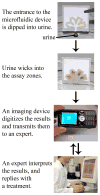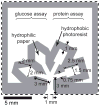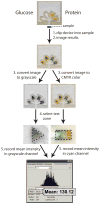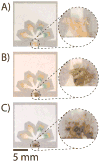Simple telemedicine for developing regions: camera phones and paper-based microfluidic devices for real-time, off-site diagnosis
- PMID: 18407617
- PMCID: PMC3761971
- DOI: 10.1021/ac800112r
Simple telemedicine for developing regions: camera phones and paper-based microfluidic devices for real-time, off-site diagnosis
Abstract
This article describes a prototype system for quantifying bioassays and for exchanging the results of the assays digitally with physicians located off-site. The system uses paper-based microfluidic devices for running multiple assays simultaneously, camera phones or portable scanners for digitizing the intensity of color associated with each colorimetric assay, and established communications infrastructure for transferring the digital information from the assay site to an off-site laboratory for analysis by a trained medical professional; the diagnosis then can be returned directly to the healthcare provider in the field. The microfluidic devices were fabricated in paper using photolithography and were functionalized with reagents for colorimetric assays. The results of the assays were quantified by comparing the intensities of the color developed in each assay with those of calibration curves. An example of this system quantified clinically relevant concentrations of glucose and protein in artificial urine. The combination of patterned paper, a portable method for obtaining digital images, and a method for exchanging results of the assays with off-site diagnosticians offers new opportunities for inexpensive monitoring of health, especially in situations that require physicians to travel to patients (e.g., in the developing world, in emergency management, and during field operations by the military) to obtain diagnostic information that might be obtained more effectively by less valuable personnel.
Figures








Similar articles
-
Microfluidic toner-based analytical devices: disposable, lightweight, and portable platforms for point-of-care diagnostics with colorimetric detection.Methods Mol Biol. 2015;1256:85-98. doi: 10.1007/978-1-4939-2172-0_6. Methods Mol Biol. 2015. PMID: 25626533
-
Microfluidic Paper-based Analytical Device for the Determination of Hexavalent Chromium by Photolithographic Fabrication Using a Photomask Printed with 3D Printer.Anal Sci. 2018;34(1):71-74. doi: 10.2116/analsci.34.71. Anal Sci. 2018. PMID: 29321462
-
Paper-based microfluidic devices for analysis of clinically relevant analytes present in urine and saliva.Anal Bioanal Chem. 2010 Jul;397(5):1821-9. doi: 10.1007/s00216-010-3718-4. Epub 2010 Apr 28. Anal Bioanal Chem. 2010. PMID: 20425107
-
Technical aspects and challenges of colorimetric detection with microfluidic paper-based analytical devices (μPADs) - A review.Anal Chim Acta. 2017 Jun 1;970:1-22. doi: 10.1016/j.aca.2017.03.037. Epub 2017 Mar 27. Anal Chim Acta. 2017. PMID: 28433054 Review.
-
Paper-based microfluidic point-of-care diagnostic devices.Lab Chip. 2013 Jun 21;13(12):2210-51. doi: 10.1039/c3lc50169h. Epub 2013 May 8. Lab Chip. 2013. PMID: 23652632 Review.
Cited by
-
Applications, challenges, and needs for employing synthetic biology beyond the lab.Nat Commun. 2021 Mar 2;12(1):1390. doi: 10.1038/s41467-021-21740-0. Nat Commun. 2021. PMID: 33654085 Free PMC article. Review.
-
Open software platform for automated analysis of paper-based microfluidic devices.Sci Rep. 2020 Jul 9;10(1):11284. doi: 10.1038/s41598-020-67639-6. Sci Rep. 2020. PMID: 32647203 Free PMC article.
-
Robust dipstick urinalysis using a low-cost, micro-volume slipping manifold and mobile phone platform.Lab Chip. 2016 May 24;16(11):2069-78. doi: 10.1039/c6lc00340k. Lab Chip. 2016. PMID: 27166097 Free PMC article.
-
Multivalent anchoring and oriented display of single-domain antibodies on cellulose.Sensors (Basel). 2009;9(7):5351-67. doi: 10.3390/s90705351. Epub 2009 Jul 7. Sensors (Basel). 2009. PMID: 22346702 Free PMC article.
-
Low-Cost Point-of-Care Monitoring of ALT and AST Is Promising for Faster Decision Making and Diagnosis of Acute Liver Injury.Diagnostics (Basel). 2023 Sep 16;13(18):2967. doi: 10.3390/diagnostics13182967. Diagnostics (Basel). 2023. PMID: 37761334 Free PMC article.
References
-
- Daar AS, Thorsteinsdóttir H, Martin DK, Smith AC, Nast S, Singer PA. Nat Genet. 2002;32:229–232. - PubMed
-
- Mabey D, Peeling RW, Ustianowski A, Perkins MD. Nat Rev Microbiol. 2004;2:231–240. - PubMed
-
- Braun RP, Vecchietti JL, Thomas L, Prins C, French LE, Gewirtzman AJ, Saurat JH, Salomon D. Arch Dermatol. 2005;141:254–258. - PubMed
-
- Dziadzio M, Hamdulay S, Reddy V, Boyce S, Keat A, Andrews J. Clin Rheumatol. 2007;26:979–980. - PubMed
Publication types
MeSH terms
Grants and funding
LinkOut - more resources
Full Text Sources
Other Literature Sources
Medical

